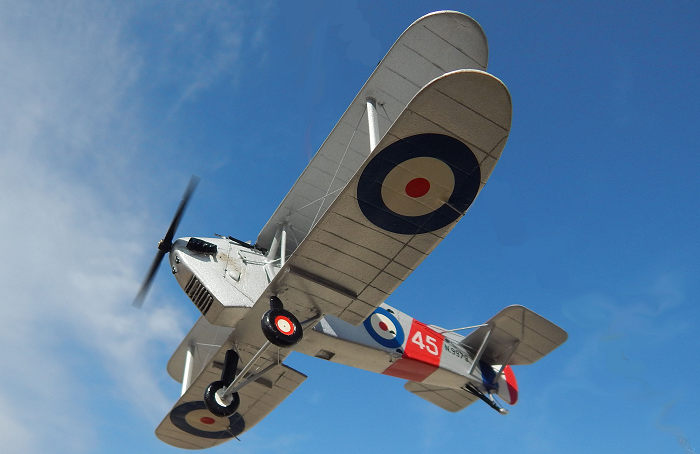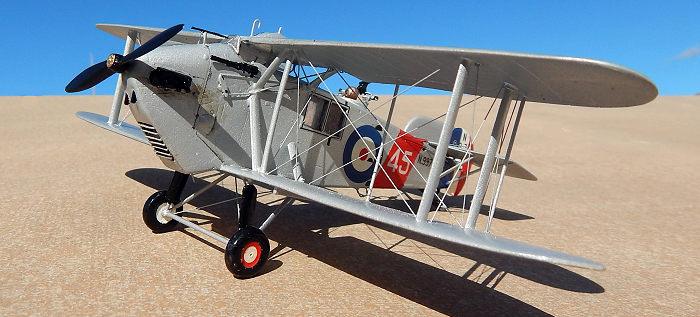
| KIT #: | |
| PRICE: | £ 11.00 |
| DECALS: | Two options |
| REVIEWER: | Carmel J. Attard |
| NOTES: | Vac form kit in white styrene, complete with white metal parts and two decal options. |

| HISTORY |
Just like the Blackburn II the Avro Bison was a fleet spotter reconnaissance aircraft for use off aircraft carriers between 1923 and 1932. The type flew from HMS Eagle, and HMS Furious. No 421, 423, 447 and 448 flights were the main users but Fleet Air Arm shore bases at Gosport, Hal Far (Malta) and Aboukir also flew the type on second line duties until 1932.
 There were three prototypes built and was
followed by 12 Bison Is and 41 Bison Iis. The latter differed from Bison Is by
having a gap between the top wing and fuselage increased and other minor
changes. The Bison was a wooden fabric-covered aircraft and was powered by a
450HP Napier Lion II engine and had a top speed of 110mph. The Bison was
replaced in FAA service by the Fairey IIIF.
There were three prototypes built and was
followed by 12 Bison Is and 41 Bison Iis. The latter differed from Bison Is by
having a gap between the top wing and fuselage increased and other minor
changes. The Bison was a wooden fabric-covered aircraft and was powered by a
450HP Napier Lion II engine and had a top speed of 110mph. The Bison was
replaced in FAA service by the Fairey IIIF.
On I st October 1925 HMS Eagle recommissioned with a new crew and No 402, 441 and 460 Flight aboard. Also on board were No 401 and 423 Flights on passing to Hermes which had left 423 Flight’s Bisons at Malta for ‘Eagle”. These first landed on deck on 14th February 1927 and the flight embarked on the 22nd. No 423 became No448 Flight and converted to Fairey IIIF. Bisons were still aboard in the shape of No 421B Flight and one of these, N9838 (24) ditched off Platea (Greece) on 26th January 1928.
Bisons embarked operationally from February 1926 to April 1929. The scale model represents a Bison II of 421 Flight. The type visited Malta in 1924 aboard HMS Furious Bison I’s from 423 (FS) Flt on board HMS Eagle visited Hal Far from February 1926 till March 1924 while those of 431B Flight HMS Eagle were at Hal Far between April 1927 until April 1928.
| THE KIT |
The kit comes sealed in a polytene bag complete with a good decal sheet offering a Bison from 421 Flight HMS Furious and 445 Flight HMS Courageous, in their respective colours. A good instruction sheet comprising history and detailed method of construction is included.
| CONSTRUCTION |
 Like any vac form
kit, parts are first removed from backing sheet followed by rubbing down and
checking with plans. Other plastic is removed from cockpit, gun ring, side
windows and exhausts. The interior was built making reference to related
material for the Bison. Fin and rudder, tail planes all sanded and rib lines
scribed to under tail plane. Cockpit interior and inner fuselage halves painted.
Upper and lower wings were sanded and a lower surface added in each wing
underside made from thin plastic card. Under surface ribbing detail added to
each wing.
Like any vac form
kit, parts are first removed from backing sheet followed by rubbing down and
checking with plans. Other plastic is removed from cockpit, gun ring, side
windows and exhausts. The interior was built making reference to related
material for the Bison. Fin and rudder, tail planes all sanded and rib lines
scribed to under tail plane. Cockpit interior and inner fuselage halves painted.
Upper and lower wings were sanded and a lower surface added in each wing
underside made from thin plastic card. Under surface ribbing detail added to
each wing.
The cockpit and compartment interior attached to left fuselage halve. Radiator part added to under nose area once the fuselage halves were glued together. Struts and rod provided were cut to size for main wings, tail plane and undercarriage axle as well ass to tail skid.
 A portion of lower
fuselage section was cut and the lower wing slotted in. Alignment was checked
with scale plans.. Struts added to lower wing, glued to points indicated at the
top of lower wing. Top wing was then added. Tail plane/ rudder assembly added to
rear-most section of fuselage and tail plane struts added to lower surface and
rear fuselage. Finally the undercarriage was added to under fuselage and checked
again with plans for correct position and angle. Tailskid added, gun ring added
and propeller was added at the very end after paintwork. Careful rigging from
thin fishing line, which passed and secured through pre drilled tiny holes.
A portion of lower
fuselage section was cut and the lower wing slotted in. Alignment was checked
with scale plans.. Struts added to lower wing, glued to points indicated at the
top of lower wing. Top wing was then added. Tail plane/ rudder assembly added to
rear-most section of fuselage and tail plane struts added to lower surface and
rear fuselage. Finally the undercarriage was added to under fuselage and checked
again with plans for correct position and angle. Tailskid added, gun ring added
and propeller was added at the very end after paintwork. Careful rigging from
thin fishing line, which passed and secured through pre drilled tiny holes.
Model was sprayed overall silver finish with a red slanting band at rear fuselage. Decals adhered well and retained the top quality properties in spite of age.
| CONCLUSIONS |
The Avro Bison was another fleet spotter type that equipped FAA which conducted the early crew deck landing operations and another type that was frequently spotted flying all over airspace over Malta back in mid 20s era.
2 December 2019
Copyright ModelingMadness.com
If you would like your product reviewed fairly and fairly quickly, please contact the editor or see other details in the Note to Contributors.
Back to the Main Page Back to the Review Index Page Back to the Previews Index Page